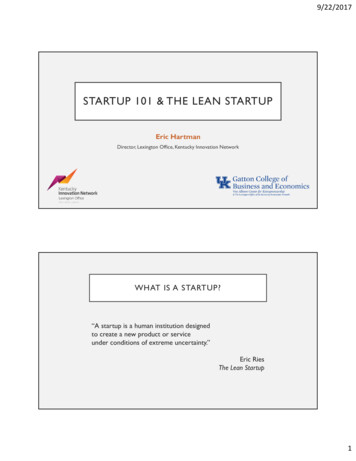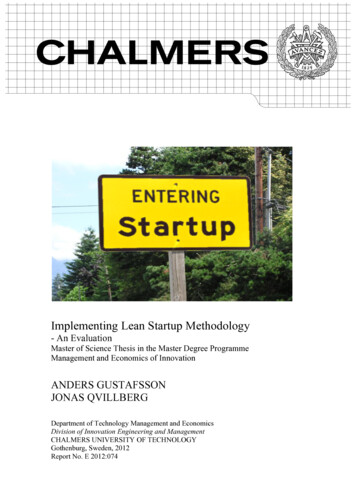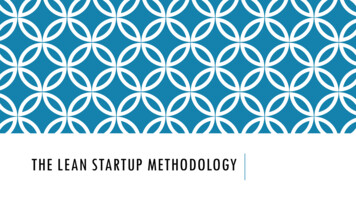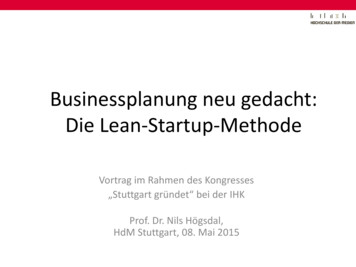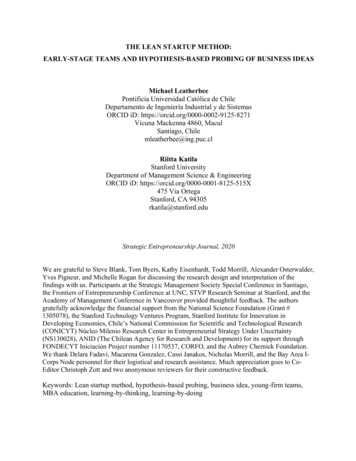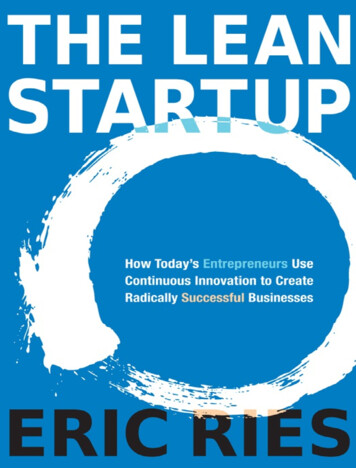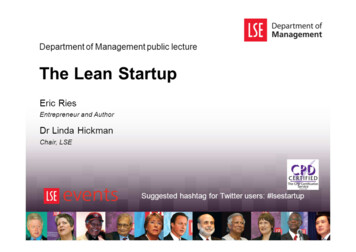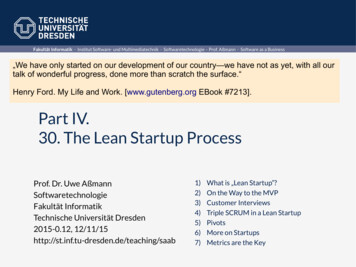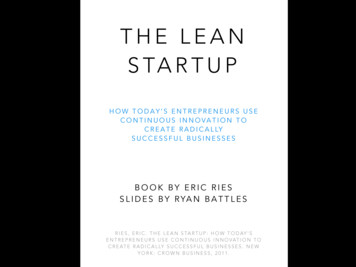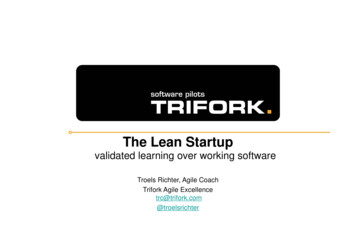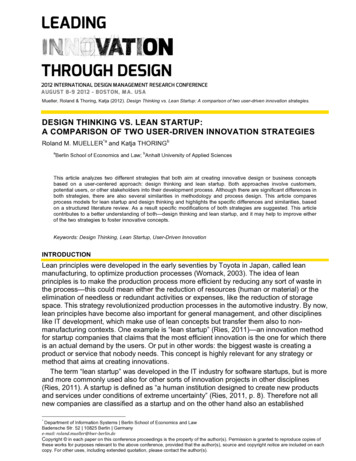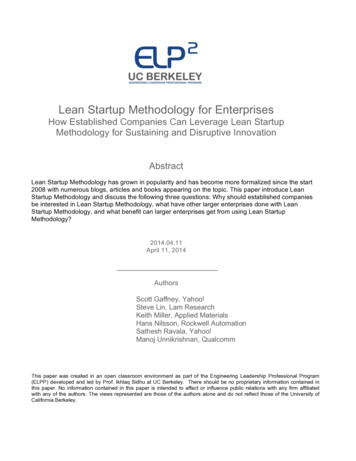
Transcription
Lean Startup Methodology for EnterprisesHow Established Companies Can Leverage Lean StartupMethodology for Sustaining and Disruptive InnovationAbstractLean Startup Methodology has grown in popularity and has become more formalized since the start2008 with numerous blogs, articles and books appearing on the topic. This paper introduce LeanStartup Methodology and discuss the following three questions: Why should established companiesbe interested in Lean Startup Methodology, what have other larger enterprises done with LeanStartup Methodology, and what benefit can larger enterprises get from using Lean StartupMethodology?2014.04.11April 11, 2014AuthorsScott Gaffney, Yahoo!Steve Lin, Lam ResearchKeith Miller, Applied MaterialsHans Nilsson, Rockwell AutomationSathesh Ravala, Yahoo!Manoj Unnikrishnan, QualcommThis paper was created in an open classroom environment as part of the Engineering Leadership Professional Program(ELPP) developed and led by Prof. Ikhlaq Sidhu at UC Berkeley. There should be no proprietary information contained inthis paper. No information contained in this paper is intended to affect or influence public relations with any firm affiliatedwith any of the authors. The views represented are those of the authors alone and do not reflect those of the University ofCalifornia Berkeley.
ntents1.Introduction.22.Barriers to Innovation in an Enterprise.33.Principles of the Lean Startup Methodology.44.Case Studies of Lean Startup in U.S on and Recommendation.157.References.161. IntroductionLean Startup Methodology has grown in popularity and become more formalized since EricRies started his blog on “startup lessons learned” in 2008, with numerous other blogs,articles and books published since then on the topic. This paper seeks to answer thefollowing questions(1) Why should established companies be interested in Lean Startup Methodology?(2) What have established companies been doing with Lean Startup Methodology?(3) How can enterprises get the most benefit from Lean Startup Methodology?The underlying principle that drives the lean methodology is to improve efficiency. In astartup, efficiency means knowing exactly what your customers will want, how much they willpay and exactly what the product will look like. Without knowing these things, time andmoney will be wasted following the wrong track. Established businesses already know theseanswers about their core business. In areas of high certainty, existing business processeshave been optimized to be efficient at answering these questions. However, the greater theuncertainty, the greater the chance that traditional business processes fail. In these cases,established business has a great deal in common with a startup.During times of uncertainty, there is greater chance for inflection and disruption. If theestablished business misses an inflection or disruption or someone else better manages thetransition, failure is more likely for the enterprise. The key idea is that the more disruptive anew idea or change, the more traditional management tools can fail, and the more useful arethe tools of a startup. Are times uncertain? Should enterprises worry? Yes they should. ThereLean Startup for Enterprise2
are many indicators that point to increasingdifficulty for incumbents. One example is theaverage lifetime of S&P 500 companies that issteadily decreasing.Figure1AverageLifespanonS&P500Assuming that innovation is critical for today’sincumbents, in the next section we discuss thebarriers to innovation for today’s enterprises.We then define the concepts and terms usedin Lean Startup Methodology and discusssome use case studies that show whereestablished large companies are adoptinglean startup ideas.In the discussion section, we analyze the case studies in the context of lean startup andclose the paper by summarizing what it takes for the LSM to succeed within an enterprise.2. Barriers to Innovation in an EnterpriseThe goal of unlocking innovation within an enterprise is not new. When the innovation simplyextends existing successful products or business models in an enterprise, it can beeffectively managed within the existing processes and procedures of the enterprise itself.Many of the most successful enterprises are highly skilled at this innovation, and they haveset up extensive Research & Development divisions that harness these skills. However, it ismore difficult when the innovation is not aligned with the existing products or businessmodels. In this case, the business usually does not have any processes in place to nurtureand develop such innovation, and in fact, the enterprise is stubbornly efficient at killing theinnovation1 completely before it has time even to be fully invented.It is this latter case that has troubled enterprises since the first time an entrenched companywas put out of business by a new idea. In The Innovator’s Solution2, Clay Christensen writes,“Enterprises need to innovate or perish at the face of the disruptive innovation which createsnew markets by offering features to current non-customers, or offer more convenience andlower prices to existing customers at alternate segments of the market.” It is this disruptiveinnovation that can lead to the downfall of existing businesses as well as the marketsthemselves, as in the case of Kodak not successfully making the transition to digital cameras.It is not easy for enterprises to alter their innovation focus. In Innovate or Perish3, EdwardKahn writes, “Barriers to creative innovation arises from management, process and culturalissues within the enterprise. Lack of management support, excessive bureaucracy andrationalization, and lack of coaching of the innovation teams hinder innovation within a typicalenterprise. Lack of resources and time allocation; lack of tools, criteria and metrics; and lackof an enterprise wide innovation program hinder innovation from a process perspective. Fearof failure, intolerance to out-of-box thinkers and lack of appropriate awards and recognitionthat value disruptive thinking are often not part of enterprise cultures.”In The Lean Enterprise4, Owens & Fernandez state, “In our view, the word intrapreneur is anoxymoron. The roles of employee and entrepreneur are mutually incompatible. Executives3Lean Startup for Enterprise
InsightsinEngineeringLeadershipWhitePaperwho expect salaried workers transplanted into an innovation department to come up withgreat ideas, invest the company’s capital in them, and shepherd them to market success arefooling themselves.” Creating a new innovation department that is supposed to innovatealong directions opposite to the current enterprise value model is difficult. Startups, on theother hand, have innovation and disruption in their DNA.3. Principles of the Lean Startup MethodologyA startup is a temporary organization meant to implement a new and repeatable businessmodel in conditions of extreme uncertainty. A lean startup efficiently searches for a valuablebusiness model by iteratively validating hypotheses against real users, while committing theleast amount of resources at all stages.The Lean Startup Methodology was conceived by Eric Ries and is defined as:(1)(2)(3)(4)(5)Entrepreneurs are everywhereEntrepreneurship is managementValidated learningInnovation accountingBuild-measure-learnThe first two points show the growing understanding that entrepreneurs can exist everywhereand that it is possible to train people/organizations how to take advantage of this fact. This isimperative to understand for the enterprise. If this is accepted, there needs to be acomplement to the classic R&D process, and good companies will have internal forces thatcan be utilized in the search for innovation.The third point indicates that the startup should bein search mode instead of execution mode. Thesearch may be for the product, the channel, or thecustomer. Point three also means to search asquickly and efficiently as possible. Ash Maurya5uses a Lean Canvas Model based on the BusinessModel Canvas6. The intent of the lean canvas is tospell out assumptions about the product and themarket and identify the Unique Value Proposition(UVP) offered by the startup. This search has alsobeen expressed by Eric Ries7 and his BuildMeasure-Learn cycle and by Steve Blank’s8 “getout of the building” approach to customerdiscovery. At each cycle of validated learning, thestartup should “pivot or persevere” to minimizetime wasted on a faulty approach.Lean Startup for Enterprise4Figure2Build- ‐Measure- ‐LearnCycle
A key idea of this third point is the minimum viable product (MVP). This is the minimal featureset necessary to validate an assumption about the product, market, or customer. The MVPcan be used in A/B split testing to make path finding decisions.Fourth on the list is good, actionable metrics that needs to capture the results of the testingand that can be used to understand how the learning is progressing. These metrics are oftencalled innovation accounting. One example is Dave McClure’s Five Pirate Metrics9 (AARRR).He suggests tracking customer progression through each of five stages: Acquisition,Activation, Retention, Referral, and Revenue. It is also suggested to use a ratio orcomparative metric to prevent “vanity” metrics which all go “up and to the right”. Some, likeAlistair Croll10, have suggested that at any stage, the whole startup should be driving towardsa single metric which answers the key question for that stage, called the One Metric ThatMatters (OMTM). Steve Blank has been using a formulation to define these stages, called theInvestment Readiness Level (IRL). He defines nine levels which communicate how well thestartup has established its business canvas and validated its market assumptions, MVP andUVP.We can summarize the differences between the “normal” enterprise and the lean startup inthe following table.Organizational AreaTraditionalLean StartupGoal / Business PlanExecutionDiscoveryModelBiz Model CanvasLean CanvasTesting FocusInternalExternalProductFull product launchTest (MVP)MetricsCorp acctInnovation (OMTM)StrategyRed OceanBlue OceanProcessSchedule / QualityLearningTable 1: Summary of differences between normal enterprise and Lean StartupWith the basic tenets of lean startup defined, numerous lean methodology subfields are stillemerging. These include detailed treatises on lean analytics1010, lean user experience(UX)11,12, lean customer development13, lean enterprise14 and lean branding15. There are alsonumerous workshops and business school programs teaching lean methodology16.5Lean Startup for Enterprise
InsightsinEngineeringLeadershipWhitePaper4. Case Studies of Lean Startup in EnterpriseEven though lean startup is fairly new, especially within the enterprise sector, there are someuse cases that can be valuable in creating context to the method. Each case is different in itsexecution and also point to different parts of lean startup.4.1. GEGeneral Electric has begun to embrace Lean Startup Methodology. At the Lean StartupConference in San Francisco 201317, a team of GE employees explained that they havebeen working with Eric Ries to create something called the FastWorks program.As this has grown, the FastWorks program has become an important part of GE’s strategy,as can be seen in the GE 2013 Annual Report18: “FastWorks—a set of tools and processesto develop new products quickly, achieve better outcomes for our customers, and drivequality and competitive advantage”. More details can be found in the 2013-the-year-in-reviewreport19 that writes:“In the first year, Ries trained 80 coaches exclusively dedicated to FastWorks.Together they exposed almost 1,000 GE executives to Lean Startup principles. GEalso launched 100 FastWorks projects in US, Europe, China, Russia and LatinAmerica. They range from building disruptive healthcare solutions to designing newgas turbines. GE plans to expand the program to 5,000 executives and launchhundreds of new projects next year. “GE is an ideal laboratory for applying leanpractices because of its scale,” Ries says. “This is undoubtedly the largest deploymentof Lean Startup ideas in the world.”Lean startup groups were even formed in parts of the company that were not consumerfacing, like accounting, HR, and IT (which facilitates some of the process changes thatneeded to be put in place to manage the FastWorks Projects).Some more facts of their results and experiences were shared at the 2013 Lean StartupConference. For example, GE launched a home appliance project using Lean StartupMethodology and up to the conference they had used more than 10 MVPs (real functionalhardware products), at two test sites (A/B testing) to find out what customers thought.Further, GE has also investigated what an MVP is to jet engine development and hospitalequipment development. In both these cases, it is hard to build real-to-life test versions of theproducts that customer can use. But as stated in the conference, if the MVP is used in thehealth sector to test market viability first (MVP then becomes a Market Validated Product),then V model development with FDA validation is aiming at the right target.In an investor presentation20, J.R. Immelt (CEO of GE) further explained how the FastWorksprogram contributes to GE. To enhance GE’s competitiveness, FastWorks makes GE moreProcess driven/IT, better at Test learn and it enhance product cost and margins. This leadsto lower product cost, more NPI/R&D spending and better inventory turns. Mr Immeltcontinued by saying,6Lean Startup for Enterprise
“And I've got to tell you, the speed -- one of the biggest benefits with that processing, thespeed with which it comes, is that you get to know faster, too. So you're not two-thirdsthrough a multi-year product where you've invested 100 million, 150 million, and theteam's version of success is completion, when we ought to be moving on to the nextidea. So I think this is a really big deal.”4.2. IntuitWith revenue of 4.3 billion in 2013, and with products like Turbotax, Quicken andQuickbooks, Intuit co-founder Scott Cook believes that established companies need to adopta lean model to innovation even more than start-ups do21. Scott believes that the ability toinnovate repeatedly and reliably must be carefully woven into the fabric of an organization.Intuit has set in place an innovation culture that encourages every employee to innovate andgives them the tools and resources to be successful. They include employee unstructuredtime, innovation catalyst mentors, innovation awards, lean start-in events and horizontalplanning.As part of unstructured time, Intuit employees can spend up to 10% of their time on projectsthey’re passionate about. If employees prefer, they can aggregate their unstructured Timeinto contiguous blocks. Regular project planning assumes the 10% use of unstructured Timeacross all employees22. Since its launch in 2008, the success in using unstructured timetowards innovation has generated multiple products like SnapTax, GoPayment, andViewMyPaycheck. As was described by the Intuit software product manager Carol Howe,Snaptax was created in 2009 as a document capture tool for Turbotax Online23. Based oncustomer feedback, they experimented with changing the scope of this product to be able tofill the tax data automatically for the basic customer filing returns in California with no home,no kids and no investments; this was their MVP. The resounding customer feedback withover 350,000 downloads in the first 3 weeks resulted in a new product line for Intuit. Thesuccess of Snaptax was attributed to a process deliberately facilitated by Intuit’smanagement where they created an “island of freedom” for the innovation team within Intuit.The innovation catalyst mentors are a group within Intuit who are experts in Design forDelight (D4D); where the role of design in innovation is stressed through design challenge,creating prototypes, getting feedback, iterating, and refining. This effort was started withinIntuit to galvanize the customers based on the NPS (Net Promoter Score – a customerfeedback system based on likelihood of recommending this product to friends)24. More than 8million dollars are allocated in the budget for a fiscal year towards innovation awards withinIntuit25.Horizon Planning is a key set of principles Intuit employs to balance their short- and longterm investments26. H1 offerings (Current revenue products - Turbotax and Quickbooks)aspire to deliver shareholder results while continuing to innovate and create efficiencies thatare reinvested to accelerate customer and revenue. H2 offerings (emerging offerings - IntuitOnline Payroll and Gopayment) aspire to deliver market results. H3 offerings (potential newbusiness incubated in Intuit labs) aspire to deliver “love metrics”. Love metrics include7Lean Startup for Enterprise
g measurable customer benefits, gaining active use and positive word-of-mouth(typically a high NPS or Net Promoter Score27).Scott Cook stresses the leader’s role in enabling lean startup within an enterprise23. BarathKadoba, VP business development for Intuit India, describes how his team responded to thegrand challenge of creating a business that improves the financial life of all Indians23. Herecalls that he was funded with three engineers to create a business for 1.2 billion people,but had complete independence in decision making. They focused on the farmers of Indiaand developed a mobile platform to deliver agricultural market price information. Theexperiment took 4 years, and more than 20 lean experiments; initially with the 3 engineersmanually texting the market information to these farmers for customer validation. Theoutcome was a tool called Fasal that was a resounding success within Intuit product portfolio.Mr. Cook firmly believes that Lean innovation is mandatory for achieving Intuit’s vision of“changing lives so profoundly that people can’t imagine going back to the old way.”234.3. QualcommAs noted on Steve Blank’s blog28 by Ricardo Dos Santos (who pioneered the QualcommVenture Fest (QVF) program), Qualcomm launched a company-wide innovation programcalled QVF in 2006. QVF had the following stated goals: (1) Drive innovation itself (discovernew business opportunities), (2) Foster development of innovation leaders and promoteinnovation as a shared-responsibility throughout the company culture, and (3) Learn as acompany about potential new management practices that rely less on formal and/or classicstructures.Mr. Santos recounts that Paul Jacobs, the then CEO of Qualcomm required that the newprogram be open to each and every employee and that ideas were to be implemented byexisting teams in the company. Furthermore, he wanted to ensure that the most innovativeideas were presented to the top-level executives consistently. The overall program consistedof one single innovation phase gated on each end by a selection process. The first selectionprocess identified ten or so proposals (from among hundreds) that should go forward. Theinnovation phase was a three-month-long part-time boot camp in which selected teams weretrained in entrepreneurial skills and were encouraged to explore, prototype, and discover howto make their ideas work. The second selection process awarded funding to the top teams.They were then required to behave like actual startup businesses within existing businessunits. This program had executive sponsorship from CEO, Paul Jacobs; since it broughtnovel and thought provoking ideas to his executive team’s attention. The program steadilygenerated healthy interest from Qualcomm employees with over 500 proposals after a fewyears. Several ideas were fully or partially implemented with a few breakthrough successes,and hundreds of related patents were filed.Ricardo Dos Santos recounts in Steve Blank’s blog28 that irrespective of the successes ofQVF, it had a few challenges. One of the challenges was that there was no program supportfor these new ideas after boot camp. Thus, if there was no business unit into which an ideanaturally fit, the teams did not understand how they were supposed to continue driving their8Lean Startup for Enterprise
ideas. This eliminated the most innovative and disruptive ideas from ever coming to fruition.Another challenge was that the program clashed with the existing well-proven R&D processthat had been driving innovation in the existing wireless business for some time. This wasbecause either the corresponding markets for the new ideas were outside of the existingR&D market expertise, or because the technology was still very hypothetical, risky, andreceived little attention.One recommendation from Dos Santos was to provide a more formal proof-of-concept centerthat would help validate all of the key assumptions early on. One of the more interestingfeatures of the program is that it encouraged the teams to effectively perform what is nowreferred to as customer discovery as part of the innovation phase in an iterative fashion withvery limited resources. This correlates directly to the methodologies of a lean startup.The learnings from QVF (retired after 5 years) seem to have been incorporated in the ImpaQtprogram that Qualcomm launched in 201229. Narvina Singh, who heads the impacQtprogram describes that the goal of the program is to encourage cross-divisional and crossfunctional collaboration at Qualcomm, to spark new ideas, and to inspire innovation in areasof strategic interest to Qualcomm. With a focus on technology and business innovations,where ideas are evaluated by experts & feedback is provided to foster new ideas byconnecting innovators with the domain experts in the company , ImpaQt also makesavailable micro funding (seed funding) to build the proof of concept prototypes before scalingthe ideas to new business units or products within Qualcomm.4.4. U.S GovernmentIn July 2010, when the CFPB (Consumer Financial Protection Bureau) was created by thePresident to protect American citizens from predatory lending by financial servicescompanies; Mr. Obama recognized the opportunity to add the innovative approaches of leanstartup in to the biggest enterprise, the US government30. President Obama tasked the thenCTO of United States, Mr. Aneesh Chopra with this effort. Mr. Chopra touched base withEric Ries and examined how lean startup principles could be applied and technology couldbe used to make the agency more efficient and cost-effective.Chopra and Ries thought the CFPB might be the right place to demonstrate the merits of alean startup approach by government, if they could establish a clearly defined problem,recruit a small, nimble team of innovators to design an innovative product, and then rapidlylearn from public feedback.One of the first projects where the lean startup principles were used within CFPB was theproject around combining the Truth in Lending form and the Good Faith Estimate. Thehypothesis was this would help the consumers and lenders alike, as it removed ambiguity inthe loan owed. Applying lean startup principles, the team developed a website called “KnowBefore You Owe”. The website launched in May 2011 with two draft designs (MVP)accessible online. The public was then called upon to experiment with the site and provide9Lean Startup for Enterprise
InsightsinEngineeringLeadershipWhitePaperfeedback. Mr. Chopra believed that iterating against user feedback and using technology toopen the design process has been part of a broad collaborative approach at the CFPB.Lean startup principles also were applied in the development of healthcare.gov, which waslaunched in just 90 days and at a fraction of the cost the federal government often spends onsuch endeavors. This website started off with minimal functionality and was build based offthe feedback from the consumers on the information they were looking for. Eric Ries believedthat this was one of the classic approaches of lean startup to do customer validation beforescaling.30The challenge with lean startup in Government is with the fact that taking chances in thepublic sector are not normally rewarded, so these types of approaches can be tougher toimplement. The recently announced White House-sponsored innovation fellows program isdesigned to encourage entrepreneurs to work for federal agencies for six-month timespans tohelp solve a variety of data-related challenges31.4.5. ToyotaSince the first publication of The Machine That Changed the World32, the concept, principlesand practices of “lean” have been extended from manufacturing to sales to productdevelopment. Although not as famous as its production system, Toyota’s ProductDevelopment System (TDS)33 harnesses 13 principles to enable Toyota to be efficient atreleasing successful products by integrating efforts among sales and marketing design,purchasing, engineering, manufacturing and suppliers.The first two principles of TDS are 1) establishing customer-defined value to separate valueadded from waste, and 2) front-load the product development process to explore thoroughlyalternative solutions while there is maximum design space. These are in good alignment withlean startup principles.At the 2013 Lean Startup Conference, two representatives ( Matt Kresse and Vinuth Rai )from the Toyota Infotechnology Center34 shared their experience in applying lean startupprinciples to engage customers and to solicit feedback from customers for earlierincorporation in product development. They felt that although the Toyota Production Systemused the TDS principles efficiently, customer facing aspects of the automobile includingnavigation and multimedia got customer feedback only after the vehicle launch.They used an Android tablet wired into a car as an MVP, which facilitated a direct interactionwith customers. They posted ads on craigslist to which more than 300 people responded to,and conducted a live trial with the prototype system to facilitate feedback. These trials weredeemed successful by the team, with retention at 60% and referral at 40%.Presenting these findings to Toyota Management, the response was twofold: Why is thisimportant (Toyota usually look on the whole car for customer satisfaction) and althoughinteresting, how to balance this new information/learning with the process normally driven bythe development team and the experiments that are in progress.Toyota Infotechnology Center took these questions to heart and connected with the twoToyota R&D centers in LA and Detroit, to continue working with lean startup methodology.Lean Startup for Enterprise10
The result is that continued tests with real customers, generate feedback that is sent directlyto the product teams. The hope is that by including real customer tests early, time to marketfor the system will shrink and that it also will make the product more customer-friendly,already the first time it ships.With innovations implemented at the rate of 1 million ideas each year35 , it is not clear rightnow how Toyota can or will use lean startup ideas. Only time will tell.5. DiscussionIn this section, we discuss the benefits we believe enterprises can get from using lean startupmethodology. We do this by pointing out some key aspects we’ve found while exploring leanstartup methodology and the case studies we have looked at in chapter 4. First, let’s define aprocess that enterprises can adopt to implement lean startup methodology for innovation.Figure 3 Innovation Flow-Chart in the EnterpriseWe believe it’s important for any company that wants to proceed the lean startup way tounderstand the key differences in business models between traditional and leanmethodologies. We believe there needs to be systems and/or processes in place torecognize whether an idea can be managed by the traditional business processes or whetherlean startup methodology should be applied. The decision should be based on the fivemetrics in Table 2 Idea Funnel Metrics. If not understood it might result in force feeding thefunctional organization with good ideas that no one understands how to manage. Thesechallenges can be seen in t
The Lean Startup Methodology was conceived by Eric Ries and is defined as: (1) Entrepreneurs are everywhere (2) Entrepreneurship is management (3) Validated learning (4) Innovation accounting (5) Build-measure-learn The first two points show the grow
